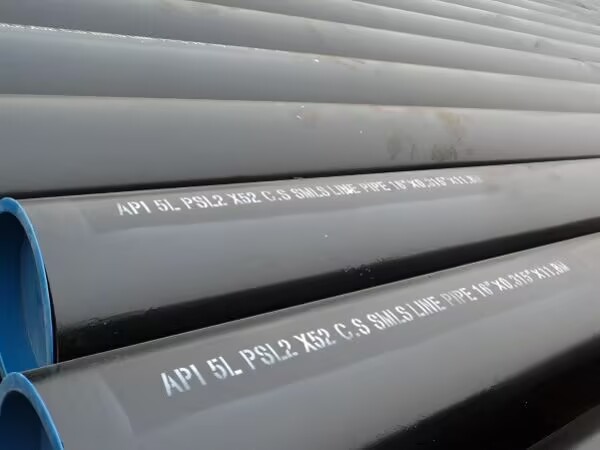API 5L is a standard for seamless and welded steel pipes for transportation issued by the American Petroleum Institute (API), covering carbon steel and alloy steel pipes for line pipe. X52 indicates that the minimum yield strength of this grade of pipe is 52 ksi (approximately 359 MPa).
API 5L X52 pipe comes in two grades, PSL1 and PSL2, and is part of the API 5L standard. It is a carbon steel seamless or welded pipe suitable for oil and gas transportation pipelines. API 5L can be classified into grades such as X42, X46, X52, X56, X60, X65, and X70 based on yield strength. API 5L X52 pipe is the most widely used pipe in the industry. It has excellent mechanical strength and high corrosion resistance, and its mechanical properties are superior to those of API 5L B grade, API 5L X42 grade, and API 5L X46 grade pipes.

Chemical composition of API 5L X52 pipe (PSL1, PSL2)
PSL1: Seamless pipe (t ≤ 25 mm): C ≤ 0.28%; Mn ≤ 1.40%; P ≤ 0.030%; S ≤ 0.030%. Welded pipe: C ≤ 0.26%; other composition rules are similar.
PSL2(X52N/Q/M):
X52N (normal): C ≤ 0.24%; Mn ≤ 1.40%; P ≤ 0.025%; S ≤ 0.015%; metallurgical elements such as Nb + V + Ti ≤ 0.15%; Cu ≤ 0.50%; Ni ≤ 0.30%; Cr ≤ 0.30%; Mo ≤ 0.15%.
X52Q (quenched and tempered): C ≤ 0.18%; Mn ≤ 1.50%; other limits are similar.
X52M (thermomechanically treated): between N and Q, for example, C ≤ 0.22%; Mn ≤ 1.40%.
For every 0.01% reduction in C, the maximum increase in Mn is 0.05%, with the maximum Mn not exceeding 1.65%.
Mechanical properties (PSL1, PSL2)
PSL1 (X52 Base Grade)
Yield strength ≥ 360 MPa (52,200 psi); tensile strength ≥ 570 MPa (82,700 psi); weld tensile strength ≥ 460 MPa (66,700 psi); elongation (denoted by Af) is calculated by formula.
PSL2 (X52N/Q/M)
Corresponding grades (N/Q/M): Yield strength 360—530 MPa (52,200—76,900 psi); tensile strength 460—760 MPa (66,700—110,200 psi); tensile strength/yield strength ≤ 0.93; weld tensile strength ≥ 460 MPa (66,700 psi).
Manufacturing process and type
Raw materials can be ingots, billets, coils or plates, and steelmaking is carried out in oxygen converters, electric furnaces or open hearth furnaces, combined with secondary refining outside the furnace. PSL2 requires that the steel be fully deoxidized and fine-grained, and coils must not have repair welds.
Pipe types include:
Seamless pipe (SMLS)
ERW / HFW resistance welded pipe (straight or spiral weld)
LSAW (longitudinal submerged arc welded)
SSAW (spiral submerged arc welded), with OD up to approximately 48-100".
Size and wall thickness range
OD range: 1/2" (~21 mm) to 24" (or larger, customizable up to 48" - 100").
Wall thickness support: Standard thicknesses such as Schedule 10, 20, STD, 40, 60, XS, 80, 100, 120, 140, 160, XXS, etc.
Length: DRL (Double Random Length), SRL (Single Random Length), 20 ft, 40 ft (approximately 6 - 14 m).
Pipe end forms: Plain end, beveled end, threaded end, etc.
Application scenarios and advantages
X52 is commonly used in oil, natural gas, water transmission pipelines and high-pressure transmission scenarios. It features high strength, high crack resistance and good corrosion resistance, making it suitable for long-distance pipelines, offshore platforms and acidic gas environments (sour-service grade is optional). PSL2 pipes particularly emphasize impact toughness and stress crack resistance, and are suitable for harsh working conditions (such as sour service with high H₂S content).
Read more:API 5L ERW carbon steel pipe
